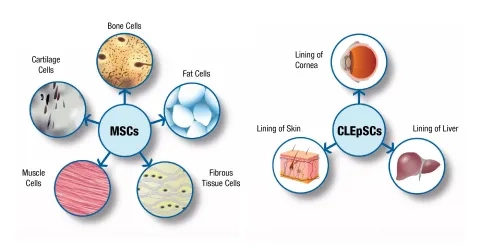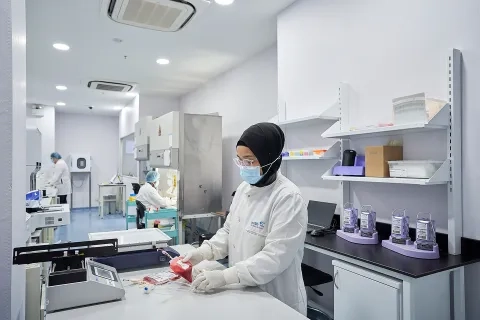This One Decision Can Safeguard the Future Health of Your Family

While anticipating the birth of your child, expectant parents have many decisions to make such as choosing your O&G doctor, your preferred delivery hospital and even whether to engage a confinement nanny. But more importantly, do you understand enough to make that one medical decision that holds the key to your baby's health?
This is deciding whether you should embark on cord blood banking for your child. Opting to store your child’s umbilical cord stem cells is something your child will be grateful for in the future, especially in this age where health issues are often unexpected and unpredictable.
What is Cord Blood?
Cord blood, also known as “placental blood”, is the blood that remains in the umbilical cord and placenta following the birth of a baby and after the umbilical cord is clamped. Cord blood is a rich source of Haematopoietic Stem Cells (HSCs) which are responsible for replenishing blood and regenerating the immune system.
Why Should I Store My Baby's Cord Blood?

In recent years, cord blood banking has become an essential part of birth planning, as cord blood can only be collected at birth. Choosing to store your baby’s cord blood is a form of biological insurance for your entire family, as this guarantees readily-available medical resources for your family’s exclusive use in the years to come and offers you a peace of mind with just one decision.
Cord Blood by the Numbers
First Transplant in 1988
The first cord blood transplant took place in 1988. More than 30 years later, researchers and physicians have continued to learn more about current and potential uses to help the body heal itself.
Potentially treat over 80+ life-threatening disesases1
Can be used as part of a stem cell transplant to help rebuild the immune system and can potentially treat over 80 life-threatening diseases1 such as leukaemia, lymphoma and thalassaemia, as well as metabolic and immune disorders.
64% of cord blood units released were used for autologous treatments2
Cord blood is a 100% match for your baby and preserving the blood from your baby’s umbilical cord in a family cord blood bank ensures that your children will always have access to their own stem cells. Since 2001, 64% of cord blood units released at Cordlife were used for autologous treatments2.
Over 59% of cord blood used for regenerative medicine2
Regenerative medicine could be a game-changer. More than 59% of the cord blood2 used by families has been for regenerative medicine applications such as Autism Spectrum Disorder, Cerebral Palsy, and many more3. Clinical trials are one of the key driving forces in medical breakthroughs and they represent hope for families with conditions that have no known cure.
Related cord blood transplants have a 95% survival rate vs. 61% for unrelated cord blood transplants4
Biological siblings have up to a 75% chance of being a genetic match5. When cord blood from a related donor is used for transplantation, the survival rate can reach as high as 95%, compared to just 61% with unrelated cord blood4. This highlights the importance of related matches in improving treatment outcomes for patients undergoing stem cell transplants.
An increasing number of parents are also choosing to store their baby’s cord lining. Cord lining is a sheet-like membrane from the umbilical cord that contains a high concentration of 2 types of stem cells, namely Mesenchymal Stem Cells (MSCs) and Cord Lining Epithelial Stem Cells (CLEpSCs). They are the ‘muscle forming’ and ‘skin-forming’ building blocks in the human body which have shown great potential in aiding the repair of injured tissues and organs.

Cord lining stem cells also have immune-modulaing characteristics, therefore matching of stem cells between the donor and the patient is not required, making them suitable for both your baby and other members of the family.
By storing a combination of HSCs, MSCs and CLEpSCs, you are availing your children and family to be part of a medical revolution with access to the growing applications of stem cells and the therapeutic potential they hold.
Did you know?
A clinical trial conducted by Dr Joanne Kurtzberg of Duke University had groundbreaking results in using umbilical cord blood infusion as a treatment for autism. The trial revealed significant improvements in social communication and expressive language in all 25 children who enrolled in the first 6 months of post-infusion6.
In 2018, KK Women’s and Children’s Hospital (KKH) also conducted a clinical trial for the treatment of Autism through autologous umbilical cord blood (child’s own cord blood) reinfusion. This clinical trial is the first of its kind to be conducted in Singapore7.
What are Cordlife’s Lab Enhancements?

Strengthened for Your Child’s Future
Cordlife prioritizes the wellbeing of every child and has taken significant steps to ensure the reliability of its services. With enhanced security measures, more advanced technology, and a dedicated team of laboratory and technical experts, Cordlife is fully committed to protecting the precious cells of each child.
Enhanced Security Through Rigorous Checks
Cordlife’s laboratory operates 365 days a year, adhering to strict protocols to safeguard your child’s cord blood. With multiple daily checks and vigilant monitoring, Cordlife ensures optimal storage conditions every day.
Newly Enhanced Lab Monitoring System
Cordlife’s advanced lab monitoring system provides 24/7 real-time on-site and remote surveillance, proactive alerts, and built-in redundancies for uninterrupted protection. They’ve also implemented a three-tiered escalation protocol to ensure swift action when needed.
Backed by Experts for Quality
Cordlife maintains rigorous quality standards in all aspects of their operations, guided by their Medical and Technical Advisory Board, which includes leading industry experts.
Fortified Failsafe Measures
Cordlife has strengthened their failsafe measures to ensure uninterrupted protection. Their systems are fortified with multiple layers of redundancy, ensuring your child’s cord blood remains secure even in the face of unexpected challenges.
Extensive Training for Cordlife’s Lab Team
Cordlife has enhanced its laboratory team’s expertise through comprehensive training programmes, ensuring they possess the knowledge and skills necessary to uphold their stringent protocols.
More Experienced Lab & Technical Personnel
Cordlife has brought onboard seasoned professionals who bring a wealth of experience to every aspect of their operations, from routine checks and cord blood processing to critical interventions.
This article was adapted from Mummys Market Shopping Magazine, Issue Jul 2025.
1 For the full list of treatable diseases and references, please refer to https://www.cordlife.com/sg/treatable-diseases.
2 Based on Cordlife’s Cord Blood Release Track Record as of March 2025.
3 Diseases and Disorders that have been in Clinical Trials with Cord Blood or Cord Tissue Cells page. Parent’s Guide to Cord Blood Foundation website. https://parentsguidecordblood.org/en/diseases#trial. Accessed May 27, 2025.
4 Bizzetto R, Bonfim C, Rocha V, et al. Outcomes after related and unrelated umbilical cord blood transplantation for hereditary bone marrow failure syndromes other than Fanconi anemia. Haematologica. 2011;96(1):134-141.
5 Jawdat D, Saleh S, Sutton P, Anazi H, Shubaili A, Tamim H, et al. Chances of Finding an HLA-Matched Sibling: The Saudi Experience. Biol Blood Marrow Transplant. 2009;15(10): 1342-1334. Accessed May 27, 2025.
6 Dawson G, Sun JM, Davlantis KS, et al. Autologous Cord Blood Infusions Are Safe and Feasible in Young Children with Autism Spectrum Disorder: Results of a Single-Center Phase I Open-Label Trial. Stem Cells Transl Med. 2017;6(5):1332-1339. doi:10.1002/sctm.16-0474.
7 KK Women’s and Children’s Hospital (KKH) Autologous Umbilical Cord Blood Reinfusion for the Treatment of Autism Clinical Trial page. Cordlife Singapore website. https://www.cordlife.com/sg/kk-women-and-children-hospital. Accessed May 14, 2025.
Recent Blog Posts
- 01 Aug 2025
- 02 Jun 2025
- 28 Mar 2025
- 10 Nov 2023
- 19 Oct 2022
